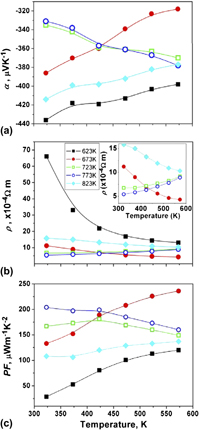Crossref Citations
This article has been cited by the following publications. This list is generated based on data provided by
Crossref.
Ge, Zhen-Hua
Zhang, Bo-Ping
and
Li, Jing-Feng
2012.
Microstructure composite-like Bi2S3 polycrystals with enhanced thermoelectric properties.
Journal of Materials Chemistry,
Vol. 22,
Issue. 34,
p.
17589.
Ge, Zhen-Hua
Zhang, Bo-Ping
Yu, Yi-Qiang
and
Shang, Peng-Peng
2012.
Fabrication and properties of Bi2−xAg3xS3 thermoelectric polycrystals.
Journal of Alloys and Compounds,
Vol. 514,
Issue. ,
p.
205.
Chen, Yue-Xing
Zhang, Bo-Ping
Ge, Zhen-Hua
and
Shang, Peng-Peng
2012.
Preparation and thermoelectric properties of ternary superionic conductor CuCrS2.
Journal of Solid State Chemistry,
Vol. 186,
Issue. ,
p.
109.
Ge, Zhen-Hua
Zhang, Bo-Ping
Liu, Yong
and
Li, Jing-Feng
2012.
Nanostructured Bi2−xCuxS3 bulk materials with enhanced thermoelectric performance.
Physical Chemistry Chemical Physics,
Vol. 14,
Issue. 13,
p.
4475.
Zhang, Li-Juan
Zhang, Bo-Ping
Ge, Zhen-Hua
and
Han, Cheng-Gong
2013.
Fabrication and properties of Bi2S3−xSex thermoelectric polycrystals.
Solid State Communications,
Vol. 162,
Issue. ,
p.
48.
Liu, Weishu
Lukas, Kevin C.
McEnaney, Kenneth
Lee, Sangyeop
Zhang, Qian
Opeil, Cyril P.
Chen, Gang
and
Ren, Zhifeng
2013.
Studies on the Bi2Te3–Bi2Se3–Bi2S3system for mid-temperature thermoelectric energy conversion.
Energy Environ. Sci.,
Vol. 6,
Issue. 2,
p.
552.
Han, Cheng-Gong
Zhang, Bo-Ping
Ge, Zhen-Hua
Zhang, Li-Juan
and
Liu, Yao-Chun
2013.
Thermoelectric properties of p-type semiconductors copper chromium disulfide CuCrS2+x.
Journal of Materials Science,
Vol. 48,
Issue. 11,
p.
4081.
Li, Jianhui
Tan, Qing
and
Li, Jing-Feng
2013.
Synthesis and property evaluation of CuFeS2−x as earth-abundant and environmentally-friendly thermoelectric materials.
Journal of Alloys and Compounds,
Vol. 551,
Issue. ,
p.
143.
Zhang, Li-Juan
Zhang, Bo-Ping
Ge, Zhen-Hua
Han, Cheng-Gong
Chen, Ning
and
Li, Jing-Feng
2013.
Synthesis and transport properties of AgBi3S5 ternary sulfide compound.
Intermetallics,
Vol. 36,
Issue. ,
p.
96.
Zou, Liang
Zhang, Bo-Ping
Ge, Zhen-Hua
Gao, Chao
Zhang, Dai-Bing
and
Liu, Yao-Chun
2013.
Size effect of SiO2on enhancing thermoelectric properties of Cu1.8S.
physica status solidi (a),
Vol. 210,
Issue. 12,
p.
2550.
Zhu, Li-Feng
Zhang, Bo-Ping
and
Yang, Wei-Gang
2014.
Enhancing piezoelectric coefficient d33 in LiF-doped BaTiO3 ceramics by optimizing excess Ba content.
Materials Research Bulletin,
Vol. 52,
Issue. ,
p.
158.
Inayat, Salman B.
Rader, Kelly R.
and
Hussain, Muhammad M.
2014.
Manufacturing of Thermoelectric Nanomaterials (Bi0.4Sb1.6Te3/Bi1.75Te3.25) and Integration into Window Glasses for Thermoelectricity Generation.
Energy Technology,
Vol. 2,
Issue. 3,
p.
292.
Zhang, Xiao
and
Zhao, Li-Dong
2015.
Thermoelectric materials: Energy conversion between heat and electricity.
Journal of Materiomics,
Vol. 1,
Issue. 2,
p.
92.
Chen, Xin Qi
Li, Zhen
and
Dou, Shi Xue
2015.
Ambient Facile Synthesis of Gram-Scale Copper Selenide Nanostructures from Commercial Copper and Selenium Powder.
ACS Applied Materials & Interfaces,
Vol. 7,
Issue. 24,
p.
13295.
Ge, Zhen‐Hua
Liu, Xiaoye
Feng, Dan
Lin, Jingyang
and
He, Jiaqing
2016.
High‐Performance Thermoelectricity in Nanostructured Earth‐Abundant Copper Sulfides Bulk Materials.
Advanced Energy Materials,
Vol. 6,
Issue. 16,
Lv, Shuai
Ge, Zhen-Hua
Chen, Yue-Xing
Zhao, Kunyu
Feng, Jing
and
He, Jiaqing
2016.
Thermoelectric properties of polycrystalline SnSe1±x prepared by mechanical alloying and spark plasma sintering.
RSC Advances,
Vol. 6,
Issue. 95,
p.
92335.
Ge, Zhen-Hua
Zhao, Li-Dong
Wu, Di
Liu, Xiaoye
Zhang, Bo-Ping
Li, Jing-Feng
and
He, Jiaqing
2016.
Low-cost, abundant binary sulfides as promising thermoelectric materials.
Materials Today,
Vol. 19,
Issue. 4,
p.
227.
Yao, Yao
Zhang, Bo-Ping
Pei, Jun
Han, Ye-Mao
and
Zhou, Min
2016.
Improved thermoelectric transport properties of Cu1.8S with NH4Cl-derived mesoscale-pores and point-defects.
Ceramics International,
Vol. 42,
Issue. 15,
p.
17518.
Lan, Yucheng
and
Ren, Zhifeng
2016.
Nanomaterials for Sustainable Energy.
p.
371.
Qin, Peng
Ge, Zhen-Hua
and
Feng, Jing
2017.
Enhanced thermoelectric properties of SiC nanoparticle dispersed Cu1.8S bulk materials.
Journal of Alloys and Compounds,
Vol. 696,
Issue. ,
p.
782.
